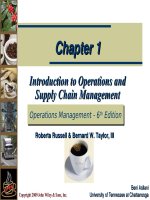Enterprise systems for management 2nd by motiwalla and thompson chapter 09
Bạn đang xem bản rút gọn của tài liệu. Xem và tải ngay bản đầy đủ của tài liệu tại đây (397.67 KB, 17 trang )
CHAPTER 8
PROGRAM AND
PROJECT
MANAGEMENT
1
Copyright © 2012 Pearson Education, Inc. Publishing as Prentice Hall
Learning Objectives
• Understand the difference between program
management and project management.
• Describe the make up of the Project Management Office
(PMO) and the areas it needs to address in an ERP
implementation.
• Appreciate the skills needed to be a project manager.
• Identify critical success factors in an ERP
implementation.
• Realize the value of a change control process for
managing scope creep.
2
Copyright © 2012 Pearson Education, Inc. Publishing as Prentice Hall
Preview
• A project team will create a strong foundation to
implement an ERP that meets the business objectives
on time and budget.
• The Project Management Office (PMO) ensures that
project teams work well together and address issues in
a timely, open, and efficient manner.
• A project manager must be able to:
–
–
–
–
Address issues related to how the system works.
Have good negotiation skills.
Work well with the teams.
Be politically savvy to navigate through the implementation.
3
Copyright © 2012 Pearson Education, Inc. Publishing as Prentice Hall
Figure 8-1 Project Management
4
Copyright © 2012 Pearson Education, Inc. Publishing as Prentice Hall
Project Team
• Program management is the coordinated management
of interdependent projects over a finite period of time in
order to achieve a set of business goals.
• Project management is tactically focused, whereas
program management is strategically focused.
• The program manager’s role is to keep all projects
moving in the same direction to achieve the business
goals outlined in the business case
• The implementation of an ERP will require several
different project teams over the course of several
months or years to manage business goals
5
Copyright © 2012 Pearson Education, Inc. Publishing as Prentice Hall
Figure 8-2 Sample Organization Project Executive
6
Copyright © 2012 Pearson Education, Inc. Publishing as Prentice Hall
Module Experts and Subject Matter Experts
• Module Experts
– Analyze requirements and convert them into solutions within the
ERP system.
– Provide direction and application knowledge with respect to
business process design, configuration, testing, training, and
implementation.
• Subject Matter Experts (SMEs)
– Provide coordination and facilitation of communications
between the project team and the organization.
– Provide leadership and functional expertise in support of the
implementation with specific knowledge in one or more
business processes.
7
Copyright © 2012 Pearson Education, Inc. Publishing as Prentice Hall
Figure 8-3 Sample Organization Teams
8
Copyright © 2012 Pearson Education, Inc. Publishing as Prentice Hall
Project Leadership
• To be successful, the PMO must manage the risks
involved in a project implementation.
• PMO will likely need to monitor or address the following
during an ERP implementation
– Project start-up (Hiring the right staff and initial setup)
– Interaction or goals between technical and functional staff
– Commitment of senior management for the length of the project
– Staff and professional consultant turnover
– Second guessing project decisions
– Passive–aggressive staff and users
9
Copyright © 2012 Pearson Education, Inc. Publishing as Prentice Hall
Figure 8-4 Sample Organization Project Management
Office
10
Copyright © 2012 Pearson Education, Inc. Publishing as Prentice Hall
Critical Success Factors
• Decision-Making Process
– A well-defined decision-making process will minimize a number of
issues related to scope, efficiency, and productivity throughout the
project implementation cycle.
• Project Scope
– Scope defines what needs to be delivered by the project, and a
changing scope means the project will have difficulty in achieving
project goals.
• Teamwork
– Project teams are assembled by bringing together staff from the
existing organization, new hires, and possible external consultants
and they need to work together for a common goal.
11
Copyright © 2012 Pearson Education, Inc. Publishing as Prentice Hall
Critical Success Factors
• Change Management
– It is up to the project manager to communicate the importance
and significance of the project to the entire organization, top to
bottom, through effective communication and training.
• Implementation Team and Executive Team
– The program manager and project manager are critical to a
successful ERP implementation.
• There are three options in choosing an implementation
team: the internal IT organization, consulting organizations,
and the package software vendors.
– Executive management support and commitment throughout
the project is essential.
12
Copyright © 2012 Pearson Education, Inc. Publishing as Prentice Hall
Managing Scope Creep
• A well thought out process to manage changes to scope
is critical to a project’s success.
• If a key element of the functionality does not work well
during this process, there may be a need to make
changes to the original scope.
• When changes are made in the scope of the project, the
options, costs, and timeframe must be documented for
the project to evaluate and decide a direction.
• White Paper—Consists of a description of the issue or
new functionality, including the options available with
advantages and disadvantages.
13
Copyright © 2012 Pearson Education, Inc. Publishing as Prentice Hall
Implications for Management
• The success or failure of a project often rests with the
skills and abilities of the PMO, project staff continuity,
and a well-defined communications process.
• The PMO must monitor a number of activities and
issues throughout the length of the implementation.
• The PMO needs to be sure that management is
always informed and up to date on the project status.
14
Copyright © 2012 Pearson Education, Inc. Publishing as Prentice Hall
Summary
• Project management and the PMO must identify/monitor
the critical success factors of an ERP implementation.
• The PMO must address daily project priorities, and also
focus on the business goals and to communicate them
continually to the teams.
• Scope creep happens when changes are requested that
are not in the initially defined project scope.
• Project leadership and the skills, knowledge and abilities of
program and project managers are important ingredient to
the success of an ERP implementation.
• Project and program managers should work together
closely during an implementation.
15
Copyright © 2012 Pearson Education, Inc. Publishing as Prentice Hall
Review Questions
1. What is the role of a project manager and program
manager?
2. What are the skills, knowledge, and abilities required
to be a project manager?
3. Name five critical success factors and why they are
important to the success of a project.
4. What role can the company executives play in an
implementation?
5. What is “scope creep” and why is it important to
manage during an ERP implementation?
16
Copyright © 2012 Pearson Education, Inc. Publishing as Prentice Hall
All rights reserved. No part of this publication may be reproduced, stored in a
retrieval system, or transmitted, in any form or by any means, electronic,
mechanical, photocopying, recording, or otherwise, without the prior written
permission of the publisher. Printed in the United States of America.
Copyright © 2012 Pearson Education, Inc.
Publishing as Prentice Hall
17
Copyright © 2012 Pearson Education, Inc. Publishing as Prentice Hall









